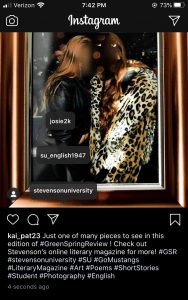
I chose to use Instagram as my social media platform to advertise the GreenSpring Review. I am most familiar with this platform, and I thought it would be effective in reaching other students. I know most college students do not utilize FaceBook much, and SnapChat does not keep posts advertised for more than 24 hours. This brought me to choose between Instagram and Twitter. I chose Instagram, though, because I thought it was important to advertise the art that you would find in the GSR, and many college students are attracted by visually appealing posts.
Since I decided to do an actual Instagram post, I had to do a caption. If I had done a post to my Instagram story, I could have done some text overlay, but I thought it was important to have an original post. Other viewers could then choose to post this to their stories to which they could add overlays. Also, font and image could be manipulated in stories, which I think increases interaction with the post. There is a word limit for the caption, but it is relatively high, and I did not want to overwhelm an audience with an exorbitant amount of text. In my opinion, a block of text on a social media post is a turn-off. I chose not to use emojis in the caption because there is not an emoji that directly correlates with Stevenson or the GSR. I did not want to add a bunch of emojis because it would make it seem rather childish to me. Once again, though, the use of emojis can be used when interacting with the post.
Pictures, videos, GIFs, etc. are all great to use on Instagram! I used a picture because it is what I had access to from my own submission. I believe any other type of media would suffice perfectly to advertise the GSR.
From my own use of Instagram and my own research, I have come to notice that there is a “prime time” to post on Instagram. I have found that this is between 5 and 8pm. It is a time students are getting off of work and out of class, so it is the time they check their social medias. To increase likes, views and comments, I used hashtags. These help bring more attention to the posts not only to SU students but everyone else in the world as well! I also tagged Stevenson’s main Instagram page as well as the GSR account I found and the SU English Department page. These are all important accounts associated with the literary magazine. Another way to get more views is by sharing the post to Instagram stories and sharing your own thoughts.

